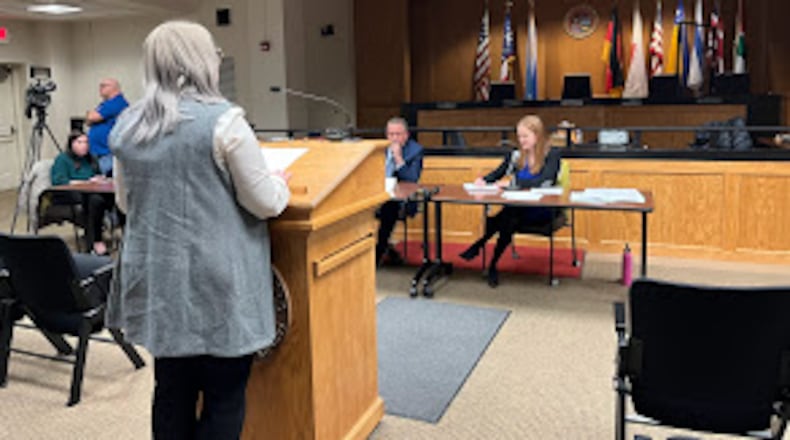While the partnership is able to help many, Gustin said what disturbs her are people who aren’t aware of HEAP benefits.
“I am begging you to hear the stories of people we cannot serve,” Gustin told an attorney and member of the Public Utilities Commission of Ohio (PUCO), who hosted the hearing.
“We are a band-aid to a much larger, larger problem ... The customers we serve are struggling,” Gustin said.
Karl Biermann, a Centerville resident, testified that in the summer his household turns off the air-conditioner — and his family keeps the thermostat as low as 61 in the winter.
“This simply feels like the final straw,” Biermann said of AES Ohio’s application.
AES Ohio, the former Dayton Power & Light, applied last September to the PUCO for a new “electric security plan” or “ESP.” An ESP establishes prices for the generation of electricity, and it may cover investments in distribution and grid modernization.
If the PUCO approves it, the plan would impose new costs, initially of less than $1 per month, on a residential customer using 750 kilowatt hours (kWh) a month ... before rising to $4 a month in new costs.
If approved, the plan would last three years, from July 1, 2023 through June 30, 2026.
According to the U.S. Energy Information Administration, the average U.S. residential customer uses about 909 kWh per month. In Ohio, the average is closer to 892 kWh a month.
The company has said the plan will allow it to “enhance and upgrade its network and improve service reliability, provide greater safeguards for price stability and continue investments in local economic development.”
Mark Vest, senior director of Ohio transmission and distribution for AES U.S. Services, said in testimony filed with the PUCO last year that 45% of AES Ohio’s substations are more than 30 years old, while 24% are over 50 years old. Over 45% of the utility’s distribution poles are more than 40 years old, and 35% are over 50 years old, Vest said.
Jeff Hoagland, president and chief executive of the Dayton Development Coalition, asked the PUCO to approve the application, testifying that the utility has been a friend to local economic development for more than a century.
Further, the utility provides power to Wright-Patterson Air Force Base, which means its service has national security implications, Hoagland said.
“Businesses must have reliable power to operate,” he said.
In all, five residents spoke before the PUCO. Four asked the commission not to approve the application or questioned the need for it.
“I’m on a fixed income and I’m having a really difficult time paying my utility bill,” Dayton resident Kathleen Galt testified. She said she recently visited an office to seek HEAP benefits and found the office “packed.”
Tom Raga, AES Ohio vice president, external relations, attended the hearing. He said the company has programs to help those who are struggling.
Rob Beeler, AES Ohio economic development lead, pointed to the company’s “gift of power” program with the Salvation Army, which allows donations to prevent service disconnections. “We contribute to those who are not able to pay their bill,” he said. “That’s a contribution we make.”
“As utilities, we don’t make bills really easy to understand, right? I’m willing to kind of say that,” Beeler added. “It’s hearings like this that give us an opportunity to bring that out and understand how the rates are driven.”
The next step for AES Ohio’s application is a PUCO evidentiary hearing in Columbus, which will happen March 6.
Information and an application for HEAP benefits can be found at https://development.ohio.gov/individual/energy-assistance/1-home-energy-assistance-program
About the Author


